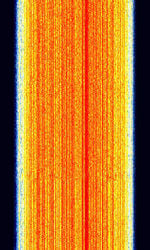Terrestrial Trunked Radio (TETRA)
 | |
|---|---|
| Frequencies | 380 MHz,860 MHz |
| Frequency Range | 380 MHz - 860 MHz |
| Mode | NFM |
| Modulation | PSK |
| ACF | Frame: 56.67 ms, Slot: 14.16 ms, Superframe: 1020 ms |
| Emission Designator | — |
| Bandwidth | 25 kHz |
| Location | Worldwide |
| Short Description | TETRA is a professional mobile radio and two-way transceiver (walkie-talkie) specification |
| I/Q Raw Recording | Download file |
| Audio Sample | |
TETRA is a professional mobile radio and two-way transceiver (walkie-talkie) specification. Formerly known as Trans-European Trunked Radio. Used extensively in Europe, especially Great Britain and Germany. Modulated with π/4 DQPSKDifferential Quadrature Phase-Shift Keying. Runs on 18000 baudBaud (unit symbol Bd) is the unit for symbol rate or modulation rate in symbols per second. with 36000 bpsBits per second (bps) maximum user bitrate. TETRA is not to be confused with Tetrapol.
Several levels of encryption are offered, however, many networks are unencrypted. For unencrypted networks, several software projects (see links below) exist allowing decoding of low-level signaling and full voice decode. There is also a basic Wireshark GSMTAP dissector and on some networks SDSs (short data messages) can be decoded.
Encryption specification is available only with NDA from ETSIEuropean Telecommunications Standards Institute. An independent, not-for-profit, standardization organization in the telecommunications industry in Europe, developing global telecommunications standards. link (requires JavaScript)
Samples[edit]
TETRA:
Frequencies[edit]
Typically between 380 MHzMegaHertz (MHz) 10^6 Hz and 430 MHzMegaHertz (MHz) 10^6 Hz.
Decoding Software[edit]
- Hobby Level Software
- osmocomTETRA
- telive
- W-CODE
- tetra-listener
- Linux Bootable Image of Telive Tetra Decoder
- tetra-multiframe-sds
- Professional Software
Video Examples[edit]
- Receving/demodulating TETRA
- Listening in to TETRA radio
- TETRA decoding and listening
- This is what TETRA sounds like if received in FM
- Finnish TETRA link @ ≈390MHz
- Tetra HackRF
Additional Links[edit]
- ETSI TETRA Technical Report 1: General Network Design
- ETSI TETRA Technical Report 2: Air Interface (Signal Modulation)
- TETRA Critical Communications Association (TCCA): TETRA Fact Sheet
- Radioreference.com TETRA
- RadioScanner.RU Tetra
- Switzerland Federal Office of Communications: Tetra Factsheet
- TETRA Analysis Spench.net
- shoc Database: TETRA
- WAVECOM Database: TETRA
- HFAsia TETRA
